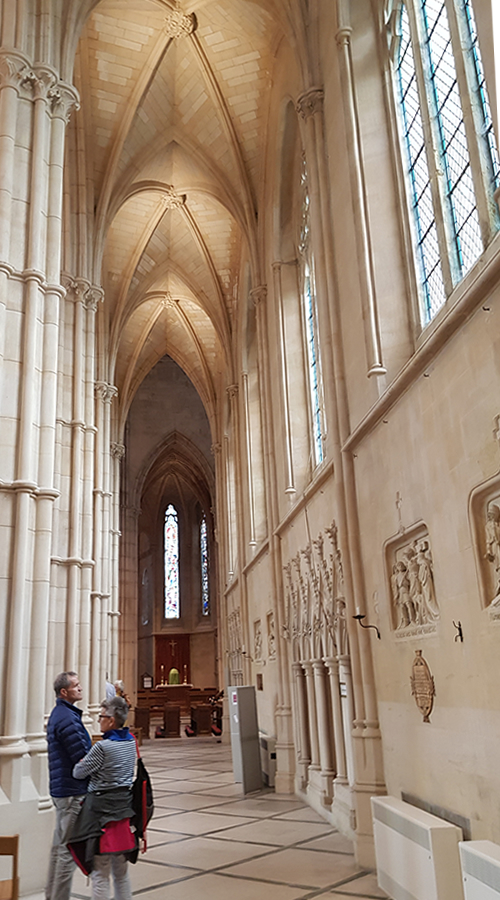South Transept and St. Philip Neri Altar
In the south transept, over the door leading to the sacristy, is a window of two lights representing Old Testament sacrifice, and the Mass, the sacrifice of the New Testament. On the right is Aaron, High Priest of the Old Law; to the left St. Peter, in bishop’s vestments and wearing the triple crown of the Popes. A Jewish priest offering sacrifices is contrasted with a Christian priest offering Mass.
Against the south wall of this transept is an altar and statue of St. Philip Neri under a lofty and delicate canopy. Together with the windows it accentuates the height of the cathedral which, both within and without, is its most remarkable quality. As mentioned earlier, Duke Henry had a particular devotion to this saint to whom the Cathedral was originally dedicated. The stained glass windows above the altar and statue depict scenes from the life of Philip Neri. The subjects, reading upwards from the lower left-hand corner are as follows:
- The boy Philip at home.
- Philip caring for poor pilgrims in a hostel which, while still a young layman, he founded for them at Rome.
- On the Vigil of Pentecost, while Philip is at prayer in the catacombs, the Holy Spirit appears as a ball of fire and enters his heart.
- The young Father Philip with the children of Rome.
- Philip plans to go to India as a missionary (note the ship’s masts) but a hermit tells him ‘Rome is to be his India’.
- At Mass, he receives an assurance of the gift of patience.
- Philip at a characteristically frugal meal.
- He greets young Englishmen studying for the priesthood at the Venerable English College in Rome – many destined to die as martyrs. It became the custom for newly-ordained English priests to ask his blessing before setting out on their dangerous mission.
- Philip, offered a ‘red hat’, protests that he would wish for the virtues of cardinals and popes but not for their dignities.
- Philip offering Mass.
- Escaping a temptation prepared for him.
- His holy death.
The wheel window above represents the twelve fruits of the Holy Spirit.
The stone plaque on the west wall of this transept, commemorates the Right Reverend David Cashman, first Bishop of Arundel and Brighton, and bears his arms: ‘Azure, a tower argent, masoned sable, charged with a cross paty gules. In chief a billet or between two cross-crosslets fichée argent. The shield is set a couché in the medieval manner’. The plaque was designed by Malcolm Lawson-Paul. The latter also designed the holy water stoop in this area, installed in 1992 in memory of a former curate’s family. The stone carver was Kenneth Child. Above the door to the right of St. Philip Neri altar is a window of Founders of the great religious orders. Reading from the lower left-hand corner they are:
- Benedict (480-543) ‘Father of Western Monasticism’, carrying his Holy Rule and with the Benedictine motto ‘PAX’ inscribed in his halo.
- Norbert (1083-1134) founder of the Praemonstratension Canons – there is now a house of this Order at nearby Storrington.
- Robert of Molesme, 1098, who instituted the Benedictine reform known as Cistercian and specially associated with St. Bernard.
- Bruno (d. 1101) founder of the Carthusian hermits, who have a large monastery at Cowfold in Sussex.
- Philip Benizi (1204-1285) one of the founders of the Servites, who had a friary at Bognor.
- Juliana Falconieri (1270-1340) first sister of the Servite Third Order.
- Bridget of Sweden (1304-1373) Princess and Foundress of the Order of our Saviour, known as Bridgettines.
- Alphonsus Liguori (1696-1787) founder of the Redemptorists.
- Vincent de Paul (1576-1660) founder of the Congregation of the Mission (Lazarists) and the Daughters of Charity.
- Ignatius Loyola (1491-1556) founder of the Society of Jesus – Jesuits.
- On the right-hand are represented:
- Anthony of Egypt (251-356) known as the first Abbot.
- Scholastica (d. C. 540) Benedict’s sister and an Abbess.
- Augustine of Hippo (354-430) whose Rule is used by some Canons, Friars and many other Orders.
- Peter Nolasco and John of Matha (d. 13th Century) founding respectively Mercedarians and Trinitarians, both for the redemption of captives.
- Francis (1182-1226) founder of the Friars Minor – the saint noted for his love of nature and animals.
- Dominic (1170-1221) founder of the Friars Preachers, known as Dominicans or Blackfriars.
- Clare (1193-1253) devoted friend of St. Francis, first Abbess of Franciscan nuns, known as Poor Ladies, or more commonly Poor Clares. There is a convent of Poor Clares at Crossbush, near Arundel Station.
- The next saint is said to be Adalbert (d. 982) Archbishop of Magdeburg but it is difficult to see why he should figure in a window of founders.
- Paul of the Cross (1694-1775) founder of the Passionists.
- Philip Neri (1515-1595) founder of the Congregation of the Oratory, of whom we have heard already when studying his window.


9,085 total views, 3 views today
